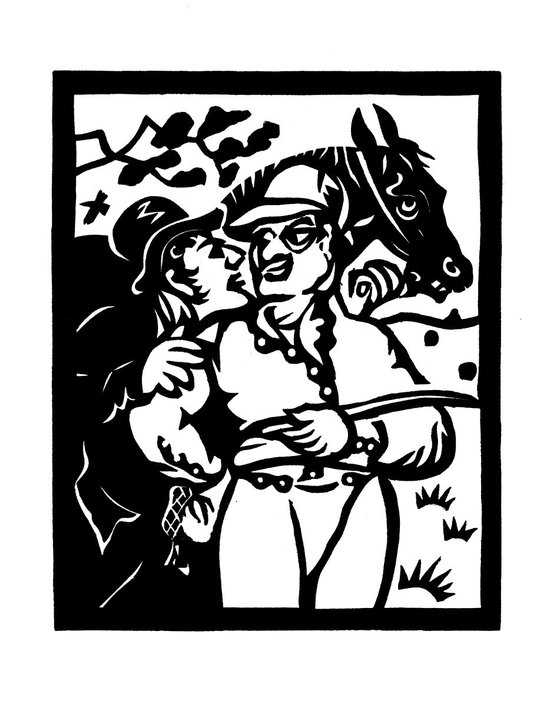- By medium
- By subject
- By budget
- Sales
- Gift cards
- Discover all art
- Artists
- Editors’ picks
- Ideas
Artwork description:
Bribery
This print is after a watercolour by Thomas Rowlandson (1756-1827) titled 'The Bribe'.
Bribery it seems is as old as mankind. Some people are hellbent and when bribery doesn't work then only violence remains. In the early nineteenth century some bookmakers devised means to influence the outcome of a race. The preferred method was to bribe a jockey to 'stop' a horse, Rowlandson's original picture showing such an arrangement. Otherwise violence on a horse, or 'nobbling', usually meant poisoning the poor creature. The worst case in the history of British racing happened in 1811, when Daniel Dawson, hired by a bookmaker to poison a horse trough in Newmarket, thereby killed several horses trained by Richard Prince. Before a crowd of 12,000 spectators the following year, on 8th August 1812 Dawson was hanged for the misdeed at the top of Castle Hill, Cambridge.
This print is pulled from an engraving cut out of a sheet of rubber, and is a variation of letterpress printing. After removal of areas that are to be left as white paper, the remaining rubber is rolled up with ink and pressed to paper. The total number of prints in this case is closed at six and the printing plate discarded.
The print comprises oil-based black ink on high quality acid free paper and should present no preserving difficulties. The image measures 5x6¼ inches on a 10x12 inch sheet and will fit straight into a standard 10x12 inch frame.
Materials used:
black oil-based printing ink, Hahnemuhle etching paper 300gsm
Tags:
#black and #letterpress #horse racing #newmarket #rowlandsonBribery (2016) Print
by Peter Long
39 Artist Reviews
£50
- Print on Paper
- From a limited edition of 6
- Size: 25.4 x 30.48cm (unframed) / 12.7 x 15.88cm (actual image size)
- Signed and numbered on the front
- Style: Expressive and gestural
- Subject: People and portraits
Loading
Artwork description
Bribery
This print is after a watercolour by Thomas Rowlandson (1756-1827) titled 'The Bribe'.
Bribery it seems is as old as mankind. Some people are hellbent and when bribery doesn't work then only violence remains. In the early nineteenth century some bookmakers devised means to influence the outcome of a race. The preferred method was to bribe a jockey to 'stop' a horse, Rowlandson's original picture showing such an arrangement. Otherwise violence on a horse, or 'nobbling', usually meant poisoning the poor creature. The worst case in the history of British racing happened in 1811, when Daniel Dawson, hired by a bookmaker to poison a horse trough in Newmarket, thereby killed several horses trained by Richard Prince. Before a crowd of 12,000 spectators the following year, on 8th August 1812 Dawson was hanged for the misdeed at the top of Castle Hill, Cambridge.
This print is pulled from an engraving cut out of a sheet of rubber, and is a variation of letterpress printing. After removal of areas that are to be left as white paper, the remaining rubber is rolled up with ink and pressed to paper. The total number of prints in this case is closed at six and the printing plate discarded.
The print comprises oil-based black ink on high quality acid free paper and should present no preserving difficulties. The image measures 5x6¼ inches on a 10x12 inch sheet and will fit straight into a standard 10x12 inch frame.
Materials used:
black oil-based printing ink, Hahnemuhle etching paper 300gsm
Tags:
#black and #letterpress #horse racing #newmarket #rowlandson14 day money back guaranteeLearn more

